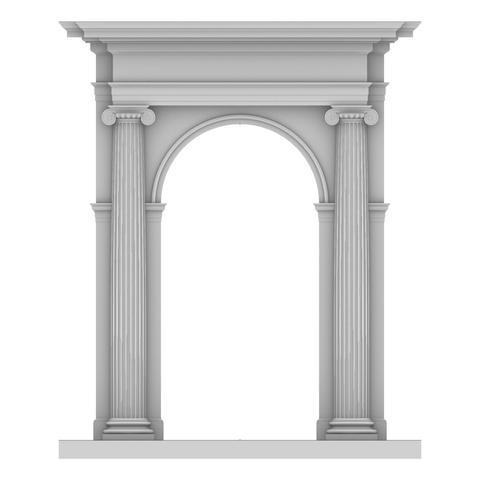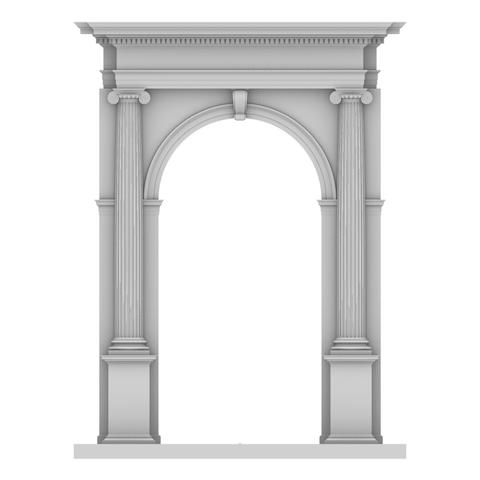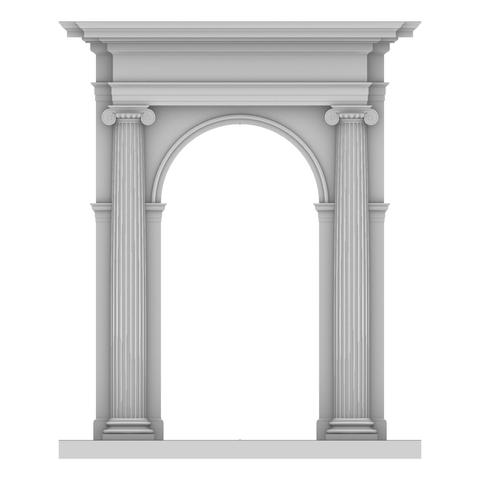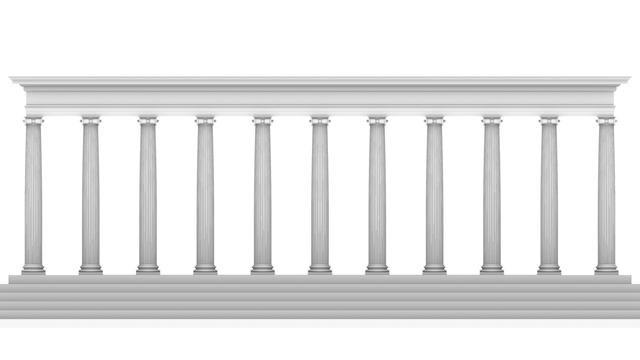Arches are made up of wedge-shaped blocks known as #voussoir. The middle one at the top of the arch has a special name — #keystone — and it is the stone that supports the most vulnerable part of the beam above and distributes its load to the adjacent blocks, which, in turn, do the same to the next lower block until the load is transferred to the #impost above a #pier.
When the arch does not include a pedestal, the arch opening is closer to the entablature, and there is no special decoration on the keystone. When there are pedestals, they add 6µ (864 units) to the total height, but the height of the opening goes up only by 5µ. So there is greater separation between the entablature and the top of the arch. In that case, there is a decoration on top of the arch to close the gap.
With pedestals, everything added for the arch has different measurement. Because of the increased height, the whole wall behind the columns is thicker — 2µ instead of 1.5µ when there is no pedestal. The pier is also wider, but its base molding is shorter. The impost profile is same, but it is wider because the pier is wider. The #archivolt is also wider, almost reaching the column shaft.
#Scarlata's book https://babel.hathitrust.org/cgi/pt?id=mdp.39015031201190&view=1up&seq=47 has all the measurements. So, I won't repeat them here.
In this post as well as in the previous one, I showed only a single arch on a flat wall with two columns half buried in the wall. When there are multiple arches running along a curve, the wall, entablature, archivolt, impost, pier, and its base are flexible and bend along the curve, but the column and pedestal are rigid. Most #CAD tools offer the option of flowing rigid bodies along a curve or curved surface — Just flow the columns and pedestals separately.

Splines (@Splines@pixelfed.social)
#Arcade #Intercolumniation without #Pedestal In https://pixelfed.social/p/Splines/803089629244302486, we saw #simpleIntercolumniation, also known as #Architravato. Roman architects combined columns with walls thick enough to bury half of the column width inside the walls and added arches to them for better load distribution. An arcade (multiple arches) can be run in series along a single wall, or in parallel to form a walkway. They can also be combined in both series and parallel configurations, perhaps the most famous of which is the #Colosseum in Rome. In the Colosseum, the outer walls follow an elliptical curve (even though it looks circular from the outside), and it has multiple tiers of arches in series. The interior has arches in concentric passageways in the lower tiers giving it a lattice-like design. Because arches distribute the load from above, they allow for wider intercolumniation. The rules for #ArcadeIntercolumniation differ depending on whether the columns have pedestals or not. Besides the arch itself, which is part of the wall, the figure shows some new architectural elements. The narrow part of the wall immediately behind a column is known as a #pier. The visible face of a pier between a column and the opening under the arch is known as #alette. The base of the pier has a molding, the flat part of which has the same height as the column base (µ) while the rest follows the #fillet and #cavetto or #conge of the #shaft. As we move up the pier, there is a horizontal molding known as #impost just below where the arc of the arch starts. The impost wraps around on the sides of the pier. Around the arc is a circular molding known as #archivolt, the bottom portion of which has a #fascia that is aligned with the face of the wall. The wall itself extends all the way to the top of the #entablature. It is worth noting that the entablature is repeated on the wall. It doesn't end at the columns and has two "outside" corners and one "inside" corner.


